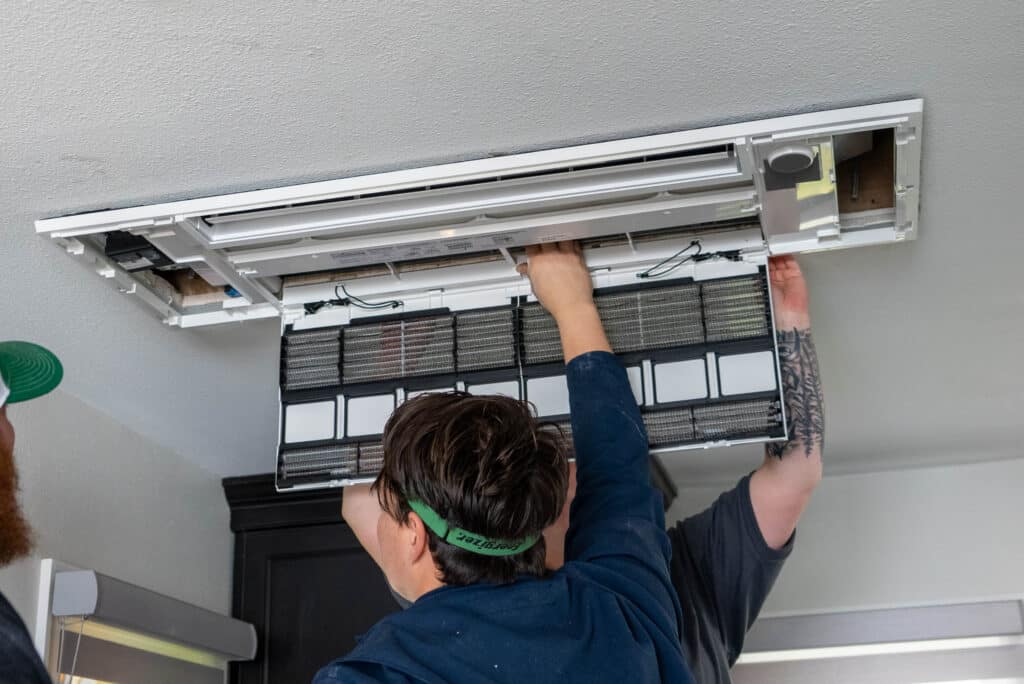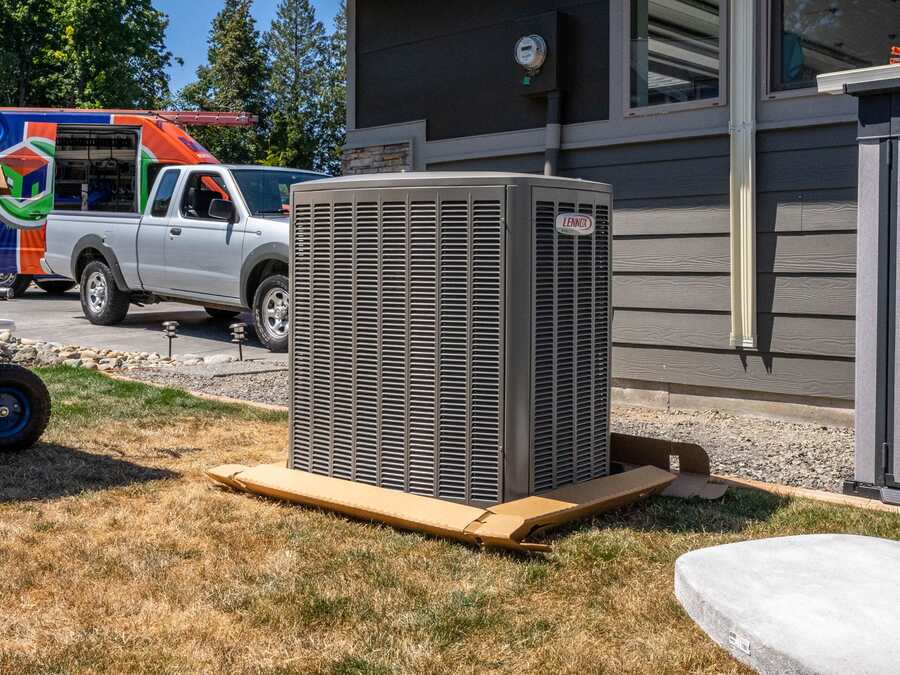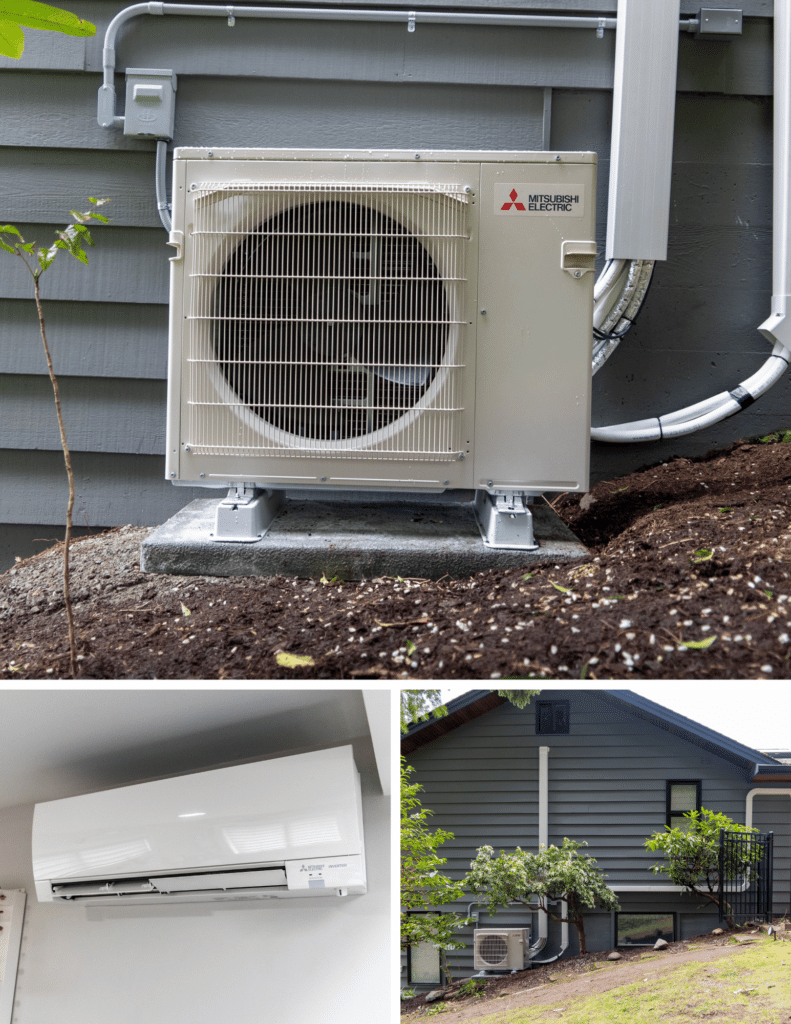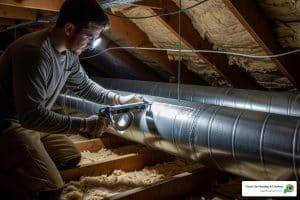The Ultimate Guide to Understanding Ductless Mini Split Systems
When it comes to modern home comfort, many homeowners ask, “how do ductless mini split systems work?”
Here’s the quick answer:
– Blower or indoor unit: Pulls warm air from your home, cools or heats it, and releases it back.
– Conduit: Connects the indoor unit to the outdoor unit, carrying refrigerant and power.
– Condenser or outdoor unit: Releases absorbed heat or pulls heat inside.
Ductless mini splits, also called ductless heating and cooling systems, consist of indoor and outdoor units working together to control your home’s temperature efficiently. Unlike traditional HVAC systems, they don’t rely on ductwork, making them perfect for homes without existing ducts or for adding comfort to specific rooms.
Why are mini splits important?
- Energy Efficiency: They reduce energy loss that occurs in ducts, potentially saving up to 30% on energy bills.
- Room-by-Room Control: You can adjust the temperature in individual rooms, increasing comfort and reducing waste.
- Flexible Installation: Ideal for retrofitting older buildings or supplementing existing systems.
Clean Air Heating & Cooling—a family-owned business in Northwest Washington—specializes in installing and maintaining these mini-split systems. If you’re thinking about upgrading your home comfort, we’ll ensure the job’s done right.

What is a Ductless Mini Split System?
A ductless mini split system is a type of heating and cooling system that doesn’t require ductwork. Unlike central HVAC systems, which use ducts to distribute air, mini splits deliver air directly to individual rooms.
Components of a Ductless Mini Split System
A typical ductless mini split system consists of several key components:
- Indoor Unit: This part is installed inside the room you want to heat or cool. It contains an evaporator coil and a blower fan.
- Outdoor Compressor: Located outside your home, this unit includes a compressor, condenser coil, and a fan.
- Refrigerant Tubing: Copper tubing that carries refrigerant between the indoor and outdoor units.
- Electrical Wiring: Provides power and control signals to the system.
Let’s dive deeper into each of these components.
Indoor Unit
The indoor unit is the part you see inside your home. It’s responsible for blowing the heated or cooled air into the room. This unit contains an evaporator coil, which absorbs heat from the indoor air, and a blower fan, which circulates the air.

Placement: Indoor units are usually mounted high on walls, but they can also be installed on the floor or ceiling, depending on your room’s layout.
Outdoor Compressor
The outdoor compressor is the powerhouse of the system. It pumps refrigerant through the refrigerant tubing to the indoor unit. This unit includes:
- Compressor: Compresses the refrigerant, increasing its temperature and pressure.
- Condenser Coil: Releases the absorbed heat to the outside air.
- Fan: Helps dissipate the heat from the condenser coil.

Installation: Typically placed on a concrete pad or lifted stilts to prevent snow or debris from obstructing it.
Refrigerant Tubing
Refrigerant tubing is the lifeline between the indoor and outdoor units. These copper tubes carry the refrigerant, which absorbs and releases heat as it cycles through the system.
Function: The refrigerant absorbs heat from the indoor air and releases it outside, or vice versa, depending on whether you’re heating or cooling.
Electrical Wiring
Electrical wiring connects the indoor and outdoor units, providing power and control signals. This wiring ensures that both units work in sync to maintain your desired room temperature.
Safety: Always hire a qualified technician to handle electrical wiring to ensure safety and compliance with local codes.
By understanding these components, you can better appreciate how a ductless mini split system works and why it might be the right choice for your home.
Next, we’ll explore the cooling and heating processes in more detail to give you a complete picture of how these systems operate.
How Do Ductless Mini Split Systems Work?
Ductless mini split systems offer a flexible and efficient solution for heating and cooling your home. Let’s break down the cooling and heating processes to understand how do ductless mini split systems work.
The Cooling Process
Evaporator Coils and Warm Air Absorption
The cooling process begins with the indoor unit, also known as the evaporator or blower unit. This unit contains cold evaporator coils filled with refrigerant. When the indoor unit’s fan pulls in warm air from the room, the air passes over these coils.
Refrigerant Cooling
As warm air flows over the cold evaporator coils, the refrigerant absorbs the heat from the air, causing the refrigerant to evaporate and turn into a gas. This process cools the air, which is then blown back into the room, lowering the room temperature.
Refrigerant Flow and Heat Transfer
The now-gaseous refrigerant travels through the conduit to the outdoor unit, or condenser. The outdoor unit compresses the refrigerant, releasing the absorbed heat into the outside air. The refrigerant then cools and returns to a liquid state, ready to cycle back to the indoor unit for more cooling.
The Heating Process
Heat Pumps and the Reverse Cycle
In heating mode, ductless mini split systems use heat pump technology to reverse the cooling process. The outdoor unit extracts heat from the outside air, even in cold weather, and transfers it inside.
Outdoor Heat Absorption
The outdoor unit’s coils absorb heat from the outside air, causing the refrigerant to evaporate into a gas. This heat-laden gas is then compressed, increasing its temperature.
Indoor Heat Release
The hot refrigerant gas travels back to the indoor unit, where it releases the absorbed heat into the room. The refrigerant cools and returns to a liquid state, ready to absorb more heat from the outside air.
By understanding these processes, you can appreciate the efficiency and versatility of ductless mini split systems in both cooling and heating your home.
Next, let’s explore the advantages of ductless mini split systems to see why they might be the perfect fit for your home.
Advantages of Ductless Mini Split Systems
Energy Efficiency
One of the standout benefits of ductless mini split systems is their energy efficiency. Traditional ducted systems can lose up to 30% of their energy through duct leaks. Mini splits bypass this issue entirely, as they transfer air directly to the indoor units.
Moreover, ductless systems use inverter compressors. These compressors adjust their speed based on the cooling or heating needs of the room, rather than turning on and off like traditional compressors. This results in precise temperature control and reduces energy consumption by 20-30% compared to ducted systems.
Zone Control
Ductless mini split systems offer unparalleled zone control. Each indoor unit can be controlled individually, allowing you to set different temperatures for different rooms. This means you can cool or heat only the rooms you use, saving energy and money.
For example, a multi-zone system can have multiple indoor units connected to a single outdoor unit. This setup is perfect for homes with varying temperature needs in different rooms. Imagine enjoying a cool living room while keeping the bedrooms slightly warmer, all controlled by individual thermostats.
Ease of Installation
Installing a ductless mini split system is much simpler than a traditional ducted system. There’s no need for extensive ductwork, which can be both time-consuming and costly. Instead, only a small hole is required to connect the indoor and outdoor units.
This ease of installation means less disruption to your home and faster setup times. Whether you’re retrofitting an old house or adding air conditioning to a new space, mini splits are a convenient option.
Quiet Operation
Ductless mini split systems are designed for quiet operation. The indoor units operate at a whisper-quiet level, often producing less noise than a traditional air conditioning system. This makes them ideal for bedrooms, offices, or any other space where noise can be a concern.
No Ductwork
As the name suggests, ductless mini split systems don’t require ductwork. This is a significant advantage for homes without existing ducts or for those looking to avoid the hassle and expense of installing new ductwork.
Without ducts, there’s also no worry about duct cleaning or maintenance. This contributes to the overall low maintenance of mini split systems.
Less Electricity
Ductless mini splits use less electricity compared to traditional systems. Because they are more efficient and avoid the energy losses associated with ductwork, your utility bills will likely be lower. This makes them a cost-effective choice in the long run.
By understanding these advantages, it’s clear why ductless mini split systems are becoming a popular choice for homeowners. Next, let’s examine some potential disadvantages to provide a balanced view.
Disadvantages of Ductless Mini Split Systems
Even though ductless mini split systems have many advantages, they come with a few drawbacks that you should consider.
Higher Initial Cost
One of the biggest disadvantages is the high initial cost. Installing a high-quality mini split system can be as expensive as buying both a traditional air conditioning and heating system at once. In some cases, it can be even more costly. This can be a major deterrent for homeowners.
However, the lifetime value of a mini split system can make up for the initial expense. These systems are energy efficient and can last for 15 years or more if well maintained.
Aesthetics
Another downside is the appearance of the units. Mini splits are more visible than systems that use ductwork. While some units have sleek, modern designs, others may stand out more than you’d like. If aesthetics are a top priority for you, this is something to keep in mind.
Maintenance Requirements
Maintaining a mini split system is crucial for its longevity and efficiency. Here are some maintenance tips:
- Filter cleaning: Clean the indoor unit’s filter every month, especially if you have pets or smoke.
- Professional servicing: Regular check-ups by an HVAC professional can keep your system running smoothly.
- Longevity tips: Make sure the unit is solidly mounted and free from debris. Clean the coils and apply a fungistat and bacteriostat to prevent biological growth.
Climate Considerations
Mini split systems are not perfect for every climate. Here are some climate limitations:
- Cold weather performance: In very cold climates, the efficiency of mini splits can drop. Some models have a backup heating system, but you may still need additional heating sources.
- Insulation needs: Proper insulation is crucial for optimal performance. Poor insulation can lead to higher energy consumption and less effective heating or cooling.
By understanding these disadvantages, you can make a more informed decision about whether a ductless mini split system is the right choice for your home. Next, let’s explore the sizing and installation process to ensure you choose the right system for your needs.
Sizing and Installation
Choosing the Right Size
Selecting the right size for your ductless mini split system is crucial. The key factor here is BTU capacity (British Thermal Units), which determines how much heat the unit can remove from a room per hour.
To find the right size, start by measuring the room size. Calculate the square footage by multiplying the room’s length by its width. For example, a 10×15 foot room would be 150 square feet.
Next, use a BTU chart to match your room size to the appropriate BTU capacity. Here’s a quick reference:
| Space to Be Cooled | BTU Capacity |
|---|---|
| 150 to 250 sq. ft. | 6,000 BTUs |
| 250 to 300 sq. ft. | 7,000 BTUs |
| 300 to 350 sq. ft. | 8,000 BTUs |
But room size isn’t the only factor. Insulation quality matters too. Poorly insulated rooms will need a higher BTU capacity. Ensure your home’s insulation is up to par to avoid energy waste and ensure effective heating and cooling.
Installation Process
Once you’ve selected the right size, the installation process begins. Here’s a simple breakdown:
Indoor Unit Placement:
– Position the indoor unit at least 6 feet above the floor.
– Avoid direct sunlight and obstructions like furniture or curtains.
– Typically installed on walls that lead directly outside.
Outdoor Unit Setup:
– Place the outdoor condenser unit on a stable surface, like a concrete pad.
– In snowy regions, consider installing it on lifted stilts or even on the roof.
– Ensure it’s in a location with good airflow and clear of debris.
Refrigerant Line Installation:
– A small hole (2-3 inches) is drilled in the wall to connect the indoor and outdoor units.
– Refrigerant, electrical, and drain lines run through this hole.
– Properly seal the hole to prevent air leaks.
By following these steps, you can ensure your ductless mini split system is installed correctly for maximum efficiency and comfort. Next, let’s dive into some frequently asked questions to address common concerns.
Frequently Asked Questions about Ductless Mini Split Systems
Do Ductless Mini Splits Use a Lot of Electricity?
No, ductless mini splits are designed to be energy-efficient. On average, they use about 60% less energy compared to traditional central air systems. This efficiency comes from their ability to cool or heat only the specific areas you need, rather than the entire home. Additionally, ductless systems avoid the energy losses associated with ductwork, which can account for up to 30% of energy consumption in central air systems.
Should Ductless Mini Splits Run All the Time?
It depends, but generally, it’s not necessary. Ductless mini splits are equipped with inverter compressors that adjust the speed based on the cooling or heating demand. This means they can run at a lower speed to maintain the desired temperature, which is more efficient than constantly turning on and off. Running them continuously at a low speed can actually be more energy-efficient and provide more consistent comfort.
How Are Ductless Mini Splits Installed?
Installation Steps:
1. Indoor Unit Placement:
– Mount the indoor unit on an interior wall, away from direct sunlight and heat sources.
– Ensure there’s enough space around the unit for proper airflow.
- Outdoor Unit Setup:
- Place the outdoor unit on a stable platform, away from debris and with good airflow.
- Ensure it’s in a location with good airflow and clear of debris.
- Refrigerant Line Installation:
- A small hole (2-3 inches) is drilled in the wall to connect the indoor and outdoor units.
- Refrigerant, electrical, and drain lines run through this hole.
- Properly seal the hole to prevent air leaks.
Professional vs DIY:
While some handy homeowners might attempt a DIY installation, it’s generally recommended to hire a professional. Proper installation ensures optimal performance and efficiency. Professionals have the tools and expertise to handle refrigerant lines and electrical connections safely, which can be challenging for a DIY project.
By addressing these common questions, we hope to clarify how ductless mini split systems can be a great addition to your home. Next, let’s wrap up with a summary of the benefits and how Clean Air Heating & Cooling can assist you.
Conclusion
To wrap things up, let’s summarize the key points about how ductless mini split systems work and why they might be the right choice for your home.
Summary
Ductless mini split systems consist of an outdoor unit and one or more indoor units connected by refrigerant tubing and electrical wiring. They offer both cooling and heating capabilities without the need for ductwork. This makes them highly versatile and suitable for various home configurations.
Benefits Recap
- Energy Efficiency: Mini splits are about 20-30% more efficient than traditional ducted systems because they don’t lose air through duct leaks.
- Zone Control: Each indoor unit operates independently, allowing you to control the temperature in different rooms.
- Easy Installation: No need for extensive ductwork. Installation is quicker and less invasive.
- Quiet Operation: Both indoor and outdoor units operate quietly, providing a comfortable environment.
- Healthier Air: Built-in filtration systems help improve indoor air quality by removing particles and contaminants.
Clean Air Heating & Cooling Services
At Clean Air Heating & Cooling, we specialize in installing, maintaining, and repairing ductless mini split systems. Our team of experts can help you choose the right system for your home and ensure it’s installed correctly for optimal performance.
Why Choose Us?
- Expert Installation: Our professionals have the expertise to install your system efficiently and safely.
- Comprehensive Maintenance: We offer regular maintenance services to keep your system running smoothly.
- Customer Support: Our team is always ready to answer your questions and provide the best solutions for your needs.
Feel free to contact us for a free consultation or to schedule a service. We look forward to helping you enjoy the many benefits of a ductless mini split system in your home.
For more information or to get started, visit our mini-split services page.





